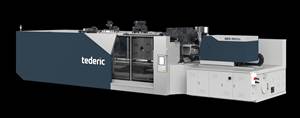Mack Moves Into Medical Disposables With New Cleanroom
At a customer’s request and after a $2 million investment in people and technology, custom molder and contract manufacturer Mack Molding, Arlington, Vt., is making its first foray into high‐volume, single‐use medical components.
In April, the company’s MackMedical division will begin validation runs of a Class III medical device manufactured in a new Class 100,000 (ISO Class 8) 3500‐sq‐ft cleanroom.
That molding and assembly cleanroom is the third at Mack’s headquarters plant in Vermont, and will it house four all-electric injection molding machines from The Japan Steel Works (JSW), bringing the company’s cleanroom press total to 11.
In a novel setup, an additional, automated 500‐ton Engel press outside the clean room will feed a larger component needed for the device into the controlled space from a soft‐walled cleanroom. In addition, servo‐controlled radio frequency and ultrasonic welding systems will be installed, as well as automated particulate, temperature and humidity monitoring.
Molding and assembly operations will include overmolding of an extruded three-lumen tubing, with the presses vacuum‐fed resin by a modular bank of dryers located just outside the cleanroom.
Jeff Somple, president of Mack Molding, and Kevin Bradley, business unit director of MackMedical told Plastics Technology that the 500-ton press would have changed the ceiling height requirements of the cleanroom and required the addition of an overhead crane. To meet the job requirements without significantly altering the cleanroom space, Mack devised the more flexible solution of the soft‐walled space.
Once fully built out and given customer demand, Mack expects the newest cleanroom to feature a total of eight injection molding machines, with six presses inside the clean room, adding two presses there, as well as two machines outside, with an additional larger machine deployed.
The four new all-electric JSWs include two 44‐ton vertical machines—the first verticals at that site—and 60‐ and 199‐ton horizontal presses. The machines are from JSW’s ‘advanced’ series and feature a 62 micro second servo control circuit for high‐speed performance, increased precision and reliable quality, according to Mack. The first machine installations bring Mack’s cleanroom press total to 11.
Mack other two other Class 100,000 cleanrooms include a molding cleanroom with six all-electric presses and an assembly cleanroom for non‐sterile packaging of medical disposables, light sonic weld assembly, and temperature‐ and humidity‐ controlled functional testing. There is also a 24‐hour whiteroom operation with four hydraulic presses dedicated to small part medical molding.
Anticipating More Business
Somple and Bradley believe the Spring completion and validation of the new cleanroom space, including large-part molding capacity, will create many new opportunities for Mack in the medical sector. “Once people see the complexity of the additional space,” Bradley said, “it really will open up the floodgates.”
Somple reiterated the growth potential and described the conflicting interests between molders and potential customers surrounding cleanrooms as a classic “Catch 22.”
“Customers don't want to be the first ones to break in your cleanroom,” Somple noted, “but you have to have a cleanroom to attract the customers.” He believes that going forward the room will provide opportunities for jobs involving hundreds of thousands of parts from four and eight-cavity tools, versus millions from an application like a 64-cavity closure.
Mack first moved into the medical market back in 2000 as it exited the computer and business equipment space, watching the segment’s revenue share climb from nothing to 40% of its business.
Investing in Human Capital
Mack also augmented its medical device engineering expertise with new hires and realigned staffing to support the growing segment. David Clatworthy, formerly of AngioDynamics Inc., and Timothy Hutchings, formerly of Covidien/Tyco Healthcare, have been hired, bringing more than 50 years of combined engineering and manufacturing experience to Mack. Clatworthy will have manufacturing engineering responsibilities for both single use and reusable orthopedic product lines at Mack, while Hutchings will have manufacturing engineering responsibilities for medical device disposables.
Both will report to Scott Hodges, who has recently been promoted to manufacturing engineering manager. A 20-year Mack veteran with experience in both quality and manufacturing engineering, Hodges most recently was responsible for all engineering, operations, production planning and compliance for the manufacture of several FDA Class III medical devices.
Hodges’ promotion is part of a recent manufacturing reorganization designed to separate engineering from production at the headquarters plant. In the past, Mack said engineers were taking on production and scheduling responsibilities, whereas going forward they will focus on cost reductions, continuing improvement efforts, and new program launches.
Related Content
All-Electric Injection Molding Machine Line Expands
Fakuma 2024: Engel unveils new e-mac 500 with “High” clamping drive and encapsulated toggle-lever mechanism.
Read MoreTederic Promotes High Technology, Broader Market Presence
Four cells are running in its booth including a 1,300-ton multimaterial system highlighting its 2K capabilities.
Read MoreNext-Generation All-Electric and Vertical Injection Molding Machines
Sodick Plustech’s VR-G and MS-G2 Series both utilize the company’s proprietary V-Line technology, separating plasticizing and injection functions, and have upgraded displays, energy efficiency, response time and more.
Read MoreConsistent Shots for Consistent Shots
An integral supplier in the effort to fast-track COVID-19 vaccine deployment, Retractable Technologies turned to Arburg and its PressurePilot technology to help deliver more than 500 million syringes during the pandemic.
Read MoreRead Next
Beyond Prototypes: 8 Ways the Plastics Industry Is Using 3D Printing
Plastics processors are finding applications for 3D printing around the plant and across the supply chain. Here are 8 examples to look for at NPE2024.
Read MorePeople 4.0 – How to Get Buy-In from Your Staff for Industry 4.0 Systems
Implementing a production monitoring system as the foundation of a ‘smart factory’ is about integrating people with new technology as much as it is about integrating machines and computers. Here are tips from a company that has gone through the process.
Read MoreFor PLASTICS' CEO Seaholm, NPE to Shine Light on Sustainability Successes
With advocacy, communication and sustainability as three main pillars, Seaholm leads a trade association to NPE that ‘is more active today than we have ever been.’
Read More






















